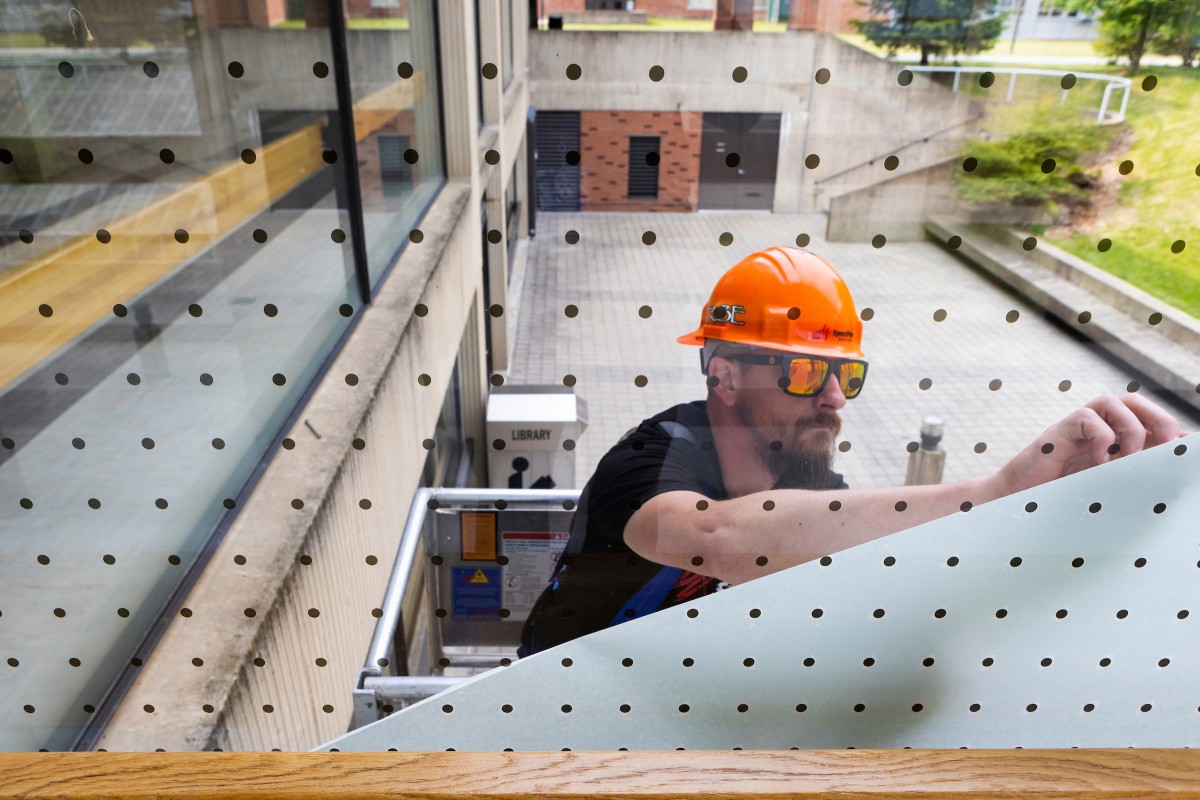Safe flight: Window treatment protects the lives of birds
Bird strikes claim a surprising amount of lives; an effort is underway to push for solutions

The robin winged directly toward the Science Library’s glass walkway, an insect in her mouth to feed her nearby young.
At the last minute, she soared upward, narrowly averting a collision with the glass — an all-too-common tragedy. Her saving grace: a subtle polka-dot pattern on the outside of the walkway windows, differentiating them from the clear blue sky. A few moments later, a sparrow also veered away from the glass, similarly deflected.
Speedpro Imaging installed the bird-deterrent film at the end of May, the first of its kind on the Binghamton University campus. Associate Professor of Biological Sciences Julian Shepherd credited Jesenko Muftic, director of design for Physical Facilities, for his management of the project.
“We hope that this will be a pilot project, which we can gather some evidence from,” Shepherd said.
Before the bird-deterrent film was installed, feathered bodies were not infrequently strewn in the Science Library courtyard: sparrows and warblers, even a screech owl whose body left a perfect impression against the glass, delineating every feather, according to Bartle Professor of Biological Sciences Anne Clark.
“I call it the Shroud of Turin,” Clark said.
The scattered remains were noticed by Shannon Miranda, a reader services coordinator in the Science Library, soon after she began her job in 2014. She started snapping photos and burying the dead birds. By 2015, she began logging the deaths on a spreadsheet with the support of Clark and Shepherd, who appreciated her efforts.
“I know it sounds a little morbid,” Miranda admitted. “But there’s definitely an increase in certain times of the year, particularly the spring and summer.”
She ended up learning a lot about bird species along the way. Her strangest find was a woodcock, but she’s also seen the sad remains of juvenile hummingbirds and many more species. Robins — her favorite bird — particularly break her heart.
Window strikes claim a multitude of feathered lives each year, with U.S. estimates ranging from 100 million to nearly a billion; researchers believe the phenomenon may contribute to the 30% decline in North American bird populations since the 1970s. In cities, tall buildings can claim the lives of hundreds, even thousands, of birds during migration. Migrating birds don’t see well at night, but make the trip then because it’s safer to navigate by the stars than risk being snatched by predators, Clark said.
Finding solutions
“They’re attracted to lights because they’re looking for horizons. When people leave lights on in these tall buildings, they just see the lights and fly toward them,” she explained. “They don’t see the buildings.”
Window glass is a problem during daytime hours, too. At certain times of day, look at a building’s windows from the outside: If conditions are right, you will see clouds and trees captured in the reflection. Or consider the enclosed campus walkway: From the ground, you can see right through to the other side. Birds have the same view.
Sometimes, the collision kills birds instantly. Other times, the stunned avian may fly to a tree and die later from the concussion or from being unable to flee predators or find food while they recover.
“There are huge numbers of birds that die that way, many of them while they’re nesting,” Clark said.
Jesse Beck, who recently graduated with a master’s degree in sustainable communities, quantified window strikes on campus for his capstone project, identifying hot spots for birds. He surmised that the Academic A Building’s glass walls would be among them, but bird strikes there turned out to be unevenly distributed. The southwest entrance drew the greatest number, likely because nearby vegetation served as a food source for robins, cedar waxwings, starlings and other birds.
“In the fall, you could see these species a lot when you walked by. I think the shrubs were pulling birds into the area, and then the windows would do what windows do,” he said.
The same plantings are used elsewhere on campus with fewer bird deaths. Beck surmises that the placement is a factor; at Academic A, they are just far enough from the building that birds can get up to full speed before striking the glass. He didn’t find any birds there in the spring when berries weren’t a factor. Other hotspots emerged due to architecture, such as the Hinman Dining Center with its large glass windows and nearby trees.
In his project, he recommended that the campus consider removing the shrubs near Academic A or trimming them to remove the berries in the fall. A bird feeder located in the corner between Academic A and the Classroom Wing should also be moved closer to the building to prevent the birds from striking the windows at full speed.
Adhesive window treatments like the one on the Science Library walkway could also prevent bird strikes at similar locations on campus, he said. For new construction, the University should consider installing bird-safe glass, which is clear to the human eye but opaque for birds, who can see in the ultraviolet. Neither solution, however, comes cheap, Clark acknowledged.
Raptor cutouts are a popular solution, but they don’t actually work; birds become accustomed to them and consider them an object they can fly around rather than a predator, Clark said. However, there are other low-tech solutions you can take to safeguard birds. Hanging strings on windows around 2 inches apart is one such option. If you work in a tall building — say, the Glenn G. Bartle Library tower — don’t leave the lights on at night during the spring or fall migration unless you have a curtain to block the light.
Long term, Clark would love to see the formation of a campus bird commission to help make Binghamton safer for our feathered friends.
“It would be great to raise the campus’ consciousness about this issue,” she said.
